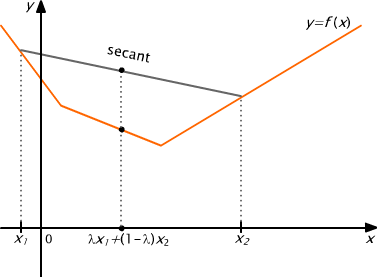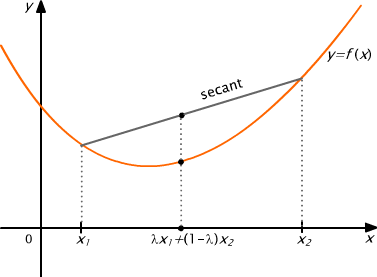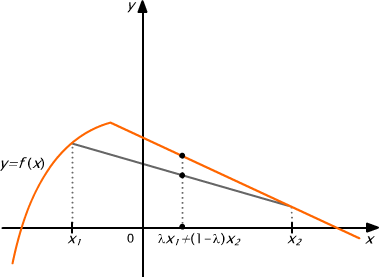| ↔ previous | next ≈ |
Definition
We say that a function f is convex in an interval P, if for any numbers x1, x2∈ P and for any number λ, 0 < λ < 1 the following condition is satisfied:
| f (λx1 + (1-λ)x2) ≤ λ f (x1) + ( 1-λ) f (x2). |
Geometrically, a function f is convex, if each point of a secant segment is located above or at the graph of the function.
Definition
We say that a function f is strictly convex in an interval P, if for any numbers x1, x2∈ P and for any number λ, 0 < λ < 1 the following condition is satisfied:
|
f (λx1 + (1-λ)x2) < λ f (x1) + ( 1-λ) f (x2). |
Geometrically, a function f is strictly convex, if each point of a secant segment connecting the points (x1, f (x1)) and (x2, f (x2)) is located above the graph of the function.
Examples of convex and strictly convex functions are shown in figures 6.1 and 6.2, respectively.

Fig. 6.1

Fig. 6.2
Definition
We say that a function f is concave in an interval P, if for any numbers x1, x2∈ P and for any number λ, 0 < λ < 1 the following condition is satisfied:
| f (λx1 + (1-λ)x2) ≥ λ f (x1) + ( 1-λ) f (x2). |
Geometrically, a function f is concave, if each point of a secant segment is located below or at the graph of the function.
Definition
We say that a function f is strictly concave in an interval P, if for any numbers x1, x2∈ P and for any number λ, 0 < λ < 1 the following condition is satisfied:
| f (λx1 + (1-λ)x2) > λ f(x1) + ( 1-λ) f (x2). |
Geometrically, a function f is strictly concave, if each point of a secant segment connecting the points (x1, f (x1)) and (x2, f (x2)) is located below the graph of the function.
Examples of concave and strictly concave functions are shown in figures 6.3 and 6.4, respectively.

Fig. 6.3

Fig. 6.4
Theorem
Let f be a function, continuous in an interval P, and differentiable in the interior of P. The function f is
Theorem
Assume a function f is continuous in an interval P and two-fold differentiable in Int P. The function f is
Corollary
• If f '' (x) > 0 for every x ∈ (a, b), then f is strictly convex in (a, b). If additionally f is continuous in [a, b], then it is also strictly convex in the interval [a, b].
• If f '' (x) < 0 for every x ∈ (a, b), then f is strictly concave in (a, b). If additionally f is continuous in [a, b], then it is also strictly concave in the interval [a, b].
Definition
Let a function f be defined on some neighborhood of a point x0. We say that a point (x0, f (x0)) is an inflection point of the function f, if there exists a number δ > 0 such that on one of the intervals (x0, x0 + δ) or (x0 - δ, x0) the function f is strictly convex, and on the second one it is strictly concave.
Remark
Instead of saying that (x0, f (x0)) is an inflection point of a function f one often says: x0 is an inflection point of f.
Theorem
Assume a function f is continuous in some neighborhood of a point x0.
(a) if n is odd then x0 is an inflection point of f.
(b) if n is even then x0 is not an inflection point of f.
Example
We will determine intervals of convexity and inflection points of the function f (x) = e -x².
The domain of f is R. The function f has derivatives of any order in the entire domain. Let us compute the second derivative of f:
![]()
Roots and the sign of the second derivative of f are exactly the same as roots and the sign of 2x² - 1, since the exponential function is always positive.
 the function f ''
changes its sign and thus x1 and x2 are the inflection points of the
function f. Additionally
the function f ''
changes its sign and thus x1 and x2 are the inflection points of the
function f. Additionally
![]()

By the above theorems f is strictly convex in the
intervals ![]() and
and ![]() , and f is strictly concave in
, and f is strictly concave in ![]() .
.
| ↔ previous | next ≈ |